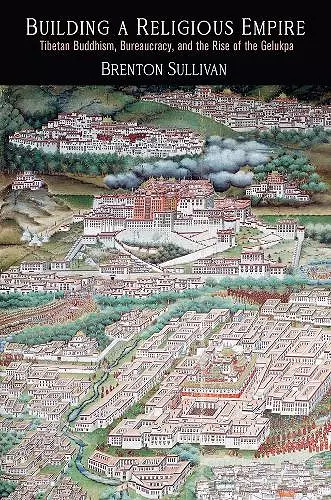Building a Religious Empire
Tibetan Buddhism, Bureaucracy, and the Rise of the Gelukpa
Format:Hardback
Publisher:University of Pennsylvania Press
Published:11th Dec '20
Currently unavailable, and unfortunately no date known when it will be back

Building a Religious Empire presents an account of the Geluk school of Tibetan Buddhism during its expansion and consolidation of power from the mid-seventeenth through the mid-eighteenth centuries, examining the extraordinary effort Geluk lamas put into establishing institutional frameworks to standardize monastic life.
The vast majority of monasteries in Tibet and nearly all of the monasteries in Mongolia belong to the Geluk school of Tibetan Buddhism, best known through its symbolic head, the Dalai Lama. Historically, these monasteries were some of the largest in the world, and even today some Geluk monasteries house thousands of monks, both in Tibet and in exile in India. In Building a Religious Empire, Brenton Sullivan examines the school's expansion and consolidation of power along the frontier with China and Mongolia from the mid-seventeenth through the mid-eighteenth centuries to chart how its rise to dominance took shape.
In contrast to the practice in other schools of Tibetan Buddhism, Geluk lamas devoted an extraordinary amount of effort to establishing the institutional frameworks within which everyday aspects of monastic life, such as philosophizing, meditating, or conducting rituals, took place. In doing so, the lamas drew on administrative techniques usually associated with state-making—standardization, record-keeping, the conscription of young males, and the concentration of manpower in central cores, among others—thereby earning the moniker "lama official," or "Buddhist bureaucrat."
The deployment of these bureaucratic techniques to extend the Geluk "liberating umbrella" over increasing numbers of lands and peoples leads Sullivan to describe the result of this Geluk project as a "religious empire." The Geluk lamas' privileging of the monastic institution, Sullivan argues, fostered a common religious identity that insulated it from factionalism and provided legitimacy to the Geluk project of conversion, conquest, and expansion. Ultimately, this system succeeded in establishing a relatively uniform and resilient network of thousands of monasteries stretching from Nepal to Lake Baikal, from Beijing to the Caspian Sea.
While this book is a must-read for anyone interested in Tibetan Buddhism and Buddhist monasticism, this is also a volume that offers rewarding insights into how religious organizations function and succeed in general and thus could be of interest to scholars studying other religious empires and traditions. * Religious Studies Review *
This work is a good start in mapping the institutional changes and constants of Gelukpa monasteries in Tibetan Buddhist regions...[T]his book is worth both reading and engaging with for its close engagements with a topic that deserves attention. * Journal of the American Academy of Religion *
A remarkable and virtually unprecedented achievement in Tibetan studies, Building a Religious Empire is an original and substantial contribution to our understanding of Tibetan Buddhist monasteries and the role they played in East Asian history. * Gray Tuttle, Columbia University *
- Commended for Honorable Mention for the E. Gene Smith Inner Asia Book Prize, granted by the Association for Asian Studies 2022 (United States)
ISBN: 9780812252675
Dimensions: unknown
Weight: unknown
304 pages